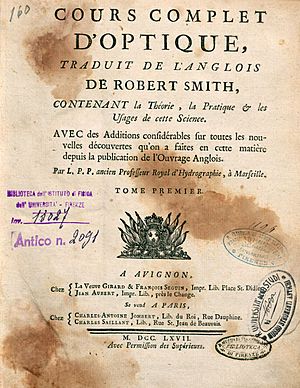Robert Smith (mathematician) facts for kids
Quick facts for kids
Robert Smith
|
|
|---|---|

Portrait by John Vanderbank, 1730
|
|
| Born | c. 16 October 1689 Lea, Lincolnshire, England
|
| Died | 2 February 1768 (aged 78) Cambridge, Cambridgeshire, England
|
| Nationality | British |
| Alma mater | Trinity College, Cambridge |
| Known for | Smith–Helmholtz equation |
| Scientific career | |
| Fields | Mathematician |
| Institutions | Trinity College, Cambridge |
| Academic advisors | Roger Cotes |
| Notable students | Walter Taylor Israel Lyons Richard Watson |
Robert Smith (born around October 16, 1689 – died February 2, 1768) was a famous English mathematician. He was known for his important work in the fields of optics and the science of sound.
Contents
Early Life and Education
Robert Smith was likely born in a place called Lea, near Gainsborough, England. His father, John Smith, was a rector, which is a type of church leader.
Robert went to Queen Elizabeth's Grammar School in Gainsborough. After that, in 1708, he started studying at Trinity College, Cambridge. This college would become a very important part of his life.
Career at Cambridge
Smith spent most of his life at Trinity College. He became a fellow, which means he was a senior member of the college, in 1714. Later, in 1742, he was chosen to be the Master of Trinity College. This was a very important leadership role.
From 1716 to 1760, Robert Smith was the Plumian Professor. This was a special job where he taught about Astronomy and how experiments work.
In 1719, he was also made a Fellow of the Royal Society. This is a group of very smart scientists and is a great honor.
Key Scientific Works
Robert Smith was very interested in the ideas of Isaac Newton, another famous scientist. Smith helped to share Newton's ideas about light and movement across Europe.
One of Smith's most important books was A Compleat System of Opticks, published in 1738. This book was all about how light works and how we see things. Because of this book, people sometimes called him "Old Focus."
He also wrote Harmonics, or the Philosophy of Musical Sounds in 1749. This book explored the science behind music and sound.
Later Life and Legacy
Robert Smith never got married. He lived with his unmarried sister, Elzimar, at Trinity College. Even though he is sometimes seen as a quiet person, he was quite social in his younger years.
However, he suffered from gout, a painful health condition. This made it harder for him to do his academic work and social activities.
Robert Smith passed away on February 2, 1768, at Trinity College. He was buried in the Trinity College Chapel.
The Smith Fund
In his will, Robert Smith left a large sum of money to the University of Cambridge. This money created something called the Smith Fund.
The money from this fund is used every year for two main things:
- It helps pay for the Smith's Prize, which is an award given to smart students.
- It also helps pay the salary for the Plumian Professor, the same job Smith once held.
Books by Robert Smith
- Robert Smith, Harmonics, or, The Philosophy of Musical Sounds, Printed by J. Bentham, and sold by W. Thurlbourn, 1749.


